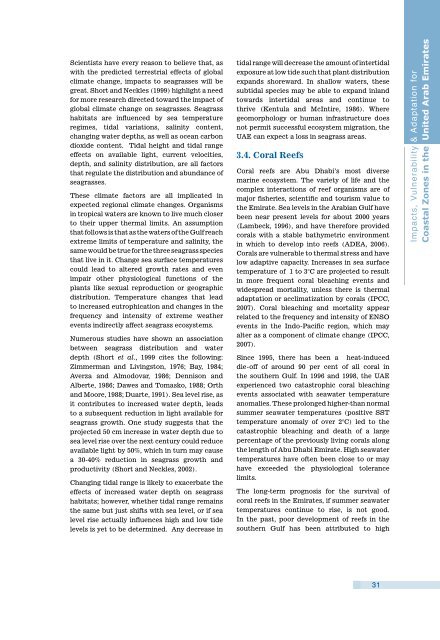climate change on UAE - Stockholm Environment Institute-US Center
climate change on UAE - Stockholm Environment Institute-US Center
climate change on UAE - Stockholm Environment Institute-US Center
You also want an ePaper? Increase the reach of your titles
YUMPU automatically turns print PDFs into web optimized ePapers that Google loves.
Scientists have every reas<strong>on</strong> to believe that, as<br />
with the predicted terrestrial effects of global<br />
<str<strong>on</strong>g>climate</str<strong>on</strong>g> <str<strong>on</strong>g>change</str<strong>on</strong>g>, impacts to seagrasses will be<br />
great. Short and Neckles (1999) highlight a need<br />
for more research directed toward the impact of<br />
global <str<strong>on</strong>g>climate</str<strong>on</strong>g> <str<strong>on</strong>g>change</str<strong>on</strong>g> <strong>on</strong> seagrasses. Seagrass<br />
habitats are influenced by sea temperature<br />
regimes, tidal variati<strong>on</strong>s, salinity c<strong>on</strong>tent,<br />
changing water depths, as well as ocean carb<strong>on</strong><br />
dioxide c<strong>on</strong>tent. Tidal height and tidal range<br />
effects <strong>on</strong> available light, current velocities,<br />
depth, and salinity distributi<strong>on</strong>, are all factors<br />
that regulate the distributi<strong>on</strong> and abundance of<br />
seagrasses.<br />
These <str<strong>on</strong>g>climate</str<strong>on</strong>g> factors are all implicated in<br />
expected regi<strong>on</strong>al <str<strong>on</strong>g>climate</str<strong>on</strong>g> <str<strong>on</strong>g>change</str<strong>on</strong>g>s. Organisms<br />
in tropical waters are known to live much closer<br />
to their upper thermal limits. An assumpti<strong>on</strong><br />
that follows is that as the waters of the Gulf reach<br />
extreme limits of temperature and salinity, the<br />
same would be true for the three seagrass species<br />
that live in it. Change sea surface temperatures<br />
could lead to altered growth rates and even<br />
impair other physiological functi<strong>on</strong>s of the<br />
plants like sexual reproducti<strong>on</strong> or geographic<br />
distributi<strong>on</strong>. Temperature <str<strong>on</strong>g>change</str<strong>on</strong>g>s that lead<br />
to increased eutrophicati<strong>on</strong> and <str<strong>on</strong>g>change</str<strong>on</strong>g>s in the<br />
frequency and intensity of extreme weather<br />
events indirectly affect seagrass ecosystems.<br />
Numerous studies have shown an associati<strong>on</strong><br />
between seagrass distributi<strong>on</strong> and water<br />
depth (Short et al., 1999 cites the following:<br />
Zimmerman and Livingst<strong>on</strong>, 1976; Bay, 1984;<br />
Averza and Almodovar, 1986; Dennis<strong>on</strong> and<br />
Alberte, 1986; Dawes and Tomasko, 1988; Orth<br />
and Moore, 1988; Duarte, 1991). Sea level rise, as<br />
it c<strong>on</strong>tributes to increased water depth, leads<br />
to a subsequent reducti<strong>on</strong> in light available for<br />
seagrass growth. One study suggests that the<br />
projected 50 cm increase in water depth due to<br />
sea level rise over the next century could reduce<br />
available light by 50%, which in turn may cause<br />
a 30-40% reducti<strong>on</strong> in seagrass growth and<br />
productivity (Short and Neckles, 2002).<br />
Changing tidal range is likely to exacerbate the<br />
effects of increased water depth <strong>on</strong> seagrass<br />
habitats; however, whether tidal range remains<br />
the same but just shifts with sea level, or if sea<br />
level rise actually influences high and low tide<br />
levels is yet to be determined. Any decrease in<br />
tidal range will decrease the amount of intertidal<br />
exposure at low tide such that plant distributi<strong>on</strong><br />
expands shoreward. In shallow waters, these<br />
subtidal species may be able to expand inland<br />
towards intertidal areas and c<strong>on</strong>tinue to<br />
thrive (Kentula and McIntire, 1986). Where<br />
geomorphology or human infrastructure does<br />
not permit successful ecosystem migrati<strong>on</strong>, the<br />
<strong>UAE</strong> can expect a loss in seagrass areas.<br />
3.4. Coral Reefs<br />
Coral reefs are Abu Dhabi’s most diverse<br />
marine ecosystem. The variety of life and the<br />
complex interacti<strong>on</strong>s of reef organisms are of<br />
major fisheries, scientific and tourism value to<br />
the Emirate. Sea levels in the Arabian Gulf have<br />
been near present levels for about 2000 years<br />
(Lambeck, 1996), and have therefore provided<br />
corals with a stable bathymetric envir<strong>on</strong>ment<br />
in which to develop into reefs (ADEA, 2006).<br />
Corals are vulnerable to thermal stress and have<br />
low adaptive capacity. Increases in sea surface<br />
temperature of 1 to 3°C are projected to result<br />
in more frequent coral bleaching events and<br />
widespread mortality, unless there is thermal<br />
adaptati<strong>on</strong> or acclimatizati<strong>on</strong> by corals (IPCC,<br />
2007). Coral bleaching and mortality appear<br />
related to the frequency and intensity of ENSO<br />
events in the Indo-Pacific regi<strong>on</strong>, which may<br />
alter as a comp<strong>on</strong>ent of <str<strong>on</strong>g>climate</str<strong>on</strong>g> <str<strong>on</strong>g>change</str<strong>on</strong>g> (IPCC,<br />
2007).<br />
Since 1995, there has been a heat-induced<br />
die-off of around 90 per cent of all coral in<br />
the southern Gulf. In 1996 and 1998, the <strong>UAE</strong><br />
experienced two catastrophic coral bleaching<br />
events associated with seawater temperature<br />
anomalies. These prol<strong>on</strong>ged higher-than normal<br />
summer seawater temperatures (positive SST<br />
temperature anomaly of over 2°C) led to the<br />
catastrophic bleaching and death of a large<br />
percentage of the previously living corals al<strong>on</strong>g<br />
the length of Abu Dhabi Emirate. High seawater<br />
temperatures have often been close to or may<br />
have exceeded the physiological tolerance<br />
limits.<br />
The l<strong>on</strong>g-term prognosis for the survival of<br />
coral reefs in the Emirates, if summer seawater<br />
temperatures c<strong>on</strong>tinue to rise, is not good.<br />
In the past, poor development of reefs in the<br />
southern Gulf has been attributed to high<br />
Impacts, Vulnerability & Adaptati<strong>on</strong> for<br />
Coastal Z<strong>on</strong>es in the United Arab Emirates<br />
31










